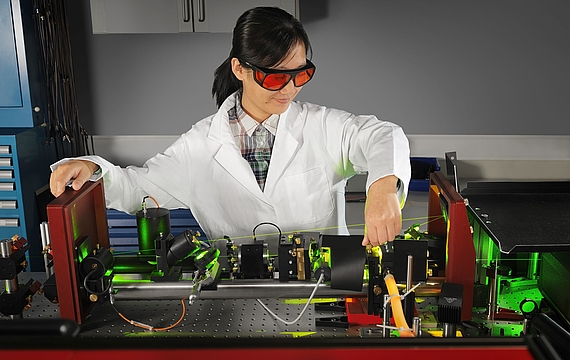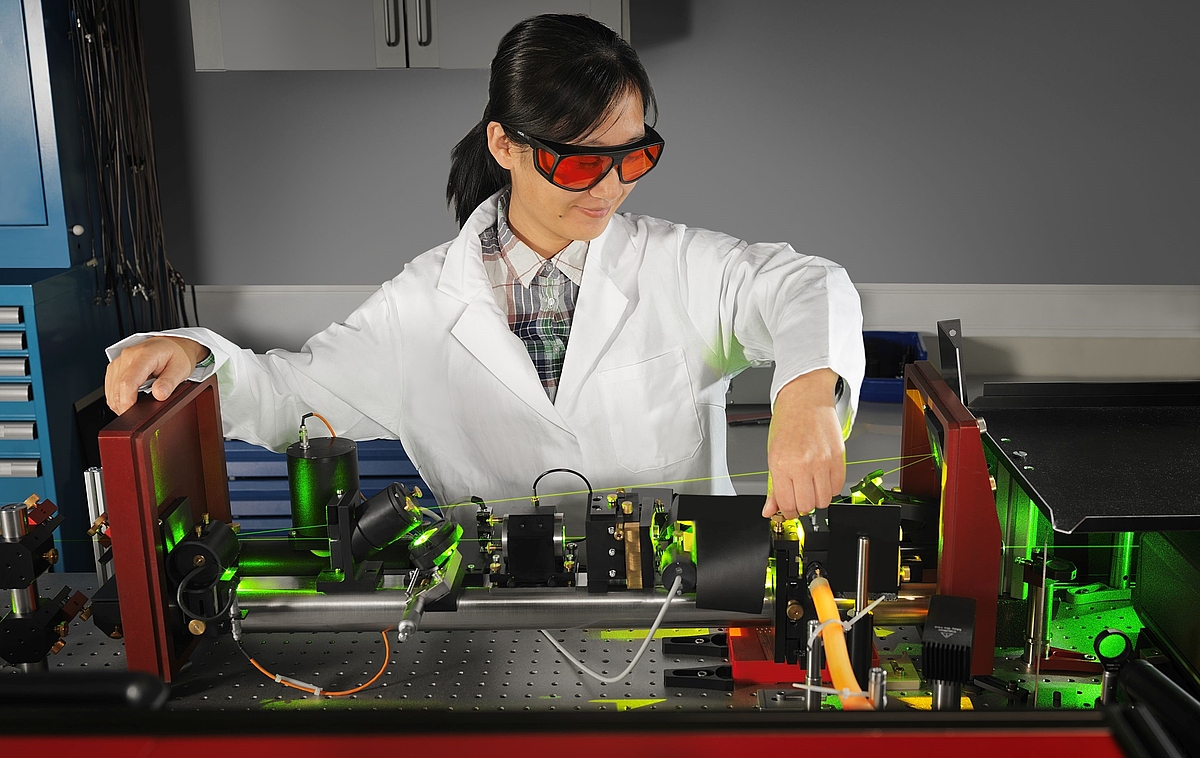


Introduction
Precision laser spectroscopy of cold molecular ions enables tests of fundamental physics inaccessible to atoms, such as probing for an electron electric dipole moment, searching for 5th forces or determining the proton radius or the proton-to-electron mass ratio μ. Diatomic molecules are ideal candidates for probing a possible time variation of μ, since their rotational and vibrational transitions scale in first order with 1/μ and 1/√μ, respectively. Many molecular ion species have been proposed for such tests, including MgH+, N+2 and O+2.
Implementing most of these proposed fundamental physics tests requires optical spectroscopy at the sub-Hertz level, comparable to what has been achieved in atomic frequency standards. In contrast, before the start of DQ-mat, optical frequency measurements of forbidden transitions in trapped molecular ions have reached a resolution ranging from 100 kHz in HD+ to a few MHz in N+2. The discrepancy between atomic and molecular spectroscopy lies in the lack of fast cycling transitions in molecules for efficient state preparation and state detection.
The main goal of this project is to establish quantum logic techniques for high precision spectroscopy of single or few molecular ions in the well-isolated environment of an ion trap and use this capability for tests of fundamental physics.
Results
We have demonstrated non-destructive molecular state detection of the rotational state of a single MgH+ molecular ion via a co-trapped 25Mg+ logic ion in a Paul trap using a variation of the quantum logic spectroscopy technique. The state detection protocol is based on a rotational-state-dependent optical dipole force that flips an engineered motional quantum bit (qubit), dependent on the rotational state of the molecular ion. Since the motional qubit is shared between the molecule and the atom, we can read it out efficiently on 25Mg+ using laser-driven quantum logic operations. The quantum logic technique implemented in this composite atom-molecule system thus provides a means for efficient, non-destructive detection of the internal state of a molecular ion, a long-sought goal in molecular spectroscopy and chemistry. We overcame limitations of the first implementation of the protocol by significantly improving the fidelity of logic operations in 25Mg+ by employing a new high-power Raman laser system at 280 nm, which allowed us to increase the Raman detuning by more than a factor of ten to 100 GHz, thus reducing detrimental off-resonant scattering during logic operations. As a consequence of an improved understanding of the Raman coupling for larger detuning, we moved from stimulated Raman adiabatic passage (STIRAP) pulses employing intensity ramps to rapid adiabatic passage (RAP) pulses employing additionally frequency ramps. This way, our fidelity in carrier operations involving only a change in electronic state as well as sideband operations involving also a change in motional state were improved to more than 95 % for a complete state inversion. As a result, the number of repetitions for internal state molecular state detection for the same state detection fidelity is reduced by around a factor of 10.
Detrimental off-resonant scattering from applying the optical dipole force on the MgH+ molecular ion can be reduced by improving the force sensitivity using engineered motional states. In contrast to previous demonstrations employing motional Schrödinger-cat or squeezed states, we have chosen to investigate motional Fock states. We developed a novel sensing protocol based on measuring the overlap between the original and a displaced Fock state. Together with project A06 and Mercator fellow A. Smerzi, we could demonstrate a sensitivity beyond the standard quantum limit (SQL) for sensing displacements, which results in a reduction in measurement time by a factor of two as well as sub-SQL measurements of the phase evolution of a displaced wavepacket.
We have investigated other molecular ion candidates besides MgH+ for their suitability for high precision measurements. We focused on homonuclear molecules, since the absence of a permanent dipole moment decouples them from black-body radiation and guarantees long lifetimes and narrow linewidths between ro-vibrational transitions. Specifically, together with project A03 we have developed a detailed quantum logic state preparation, spectroscopy, and state detection protocol for sub-Hertz spectroscopy of a vibrational overtone transition in O2+, which had been suggested for μ ̇/µ searches before.
Furthermore, together with projects A04 and A01 we have performed a theoretical investigation of dissipative state preparation in the context of a quantum simulator as a precursor study to deterministic ro-vibrational state preparation of a molecular ion. The developed state detection technique based on near-resonant oscillating dipole forces has also been applied to other systems, in particular highly charged ions (HCI), where transition energies are typically only known at the THz level.
Whereas the experiments during the first funding period were performed in an experimental setup using 25Mg+ as the logic ion, we focused during the second funding period on the new experimental system with Ca+ as the logic ion. In our revamped experimental setup, we transitioned from oven-based loading with long loading time constants to the faster method of ablation loading. This approach considerably accelerates the loading process. Instead of targeting loading individual ions, we now focus on loading larger mixed-species ensembles. Once loaded, we reduce these larger ensembles down to our target configuration which is a mixed-species two-ion crystal, consisting of a single logic and a single spectroscopy ion. The versatility of this method, which has been adopted by project B03, as well as the broad scope of our setup, becomes evident when considering the numerous distinct ion combinations, we have successfully generated and now plan to explore in our new machine, including different isotopes of Ca+, Mg+ as well as 27Al+ and 48Ti+.
To reduce off-resonant scattering of our initial state detection protocol, we have established a far-detuned Raman laser system designed for quantum-logic on transitions spanning the kHz to MHz range. For our preliminary tests, we have successfully implemented Raman transitions between the ground state Zeeman states of Ca+, including a change in motional state. Developing the theoretical framework for the interaction of a far detuned Ramam laser with a mixed species ion crystal has sparked the idea to harness this experimental platform for transferring the accuracy in polarizability determination. The potential application to frequency metrology was recognized through consistent collaboration and exchange with the clock-focused projects B02 and B03. The uncertainty in the determination of the differential polarizability of states involved in an optical clock transition poses a major limitation in accuracy of today’s most accurate optical clocks by limiting the precision with which the black body radiation shift can be determined.
We have pioneered a novel method to produce hydrides such as MgH+ and CaH+ that relies on increasing the hydrogen partial pressure by heating the getter material of a non-evaporative getter pump inside the vacuum chamber. Since many experiments already incorporate this pump, our method seamlessly integrates without necessitating additional equipment. Through this technique, we have achieved consistent and successful production of MgH+ and CaH+.
With the ability to produce molecular ions and a functional quantum logic laser tailored for Zeeman transitions in hand, we could successfully demonstrate first quantum logic manipulation of the Zeeman structure in MgH+. Since our logic laser at 532 nm dissociates MgH+, we are currently switching to an IR laser to eliminate this problem and demonstrate a new non-classical state detection protocol on MgH+, before moving on to more complex molecular species in the future.
Publications
Showing results 1 - 11 out of 11
Project leader
30167 Hannover

